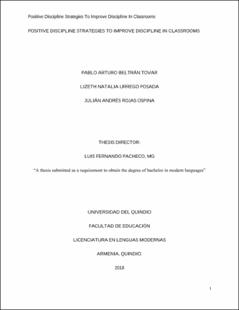Mostrar el registro sencillo del ítem
Positive discipline strategies to improve discipline in classrooms
| dc.contributor.advisor | Universidad del Quindío - Colombia - Asesor - Luis Fernando Pacheco, MG | spa |
| dc.contributor.author | Beltrán Tovar Pablo Arturo | spa |
| dc.contributor.author | Urrego Posada Lizeth Natalia | spa |
| dc.contributor.author | Rojas Ospina Julián Andrés | spa |
| dc.date.accessioned | 2018-09-12T21:40:26Z | spa |
| dc.date.available | 2018-09-12T21:40:26Z | spa |
| dc.date.issued | 2018-05-27 | spa |
| dc.identifier.uri | http://bdigital.uniquindio.edu.co/handle/001/4454 | spa |
| dc.description | Positive discipline strategies to improve discipline in classrooms | spa |
| dc.description.abstract | La investigación realizada en este proyecto obedece al nombre de “Positive Discipline Strategies To Improve Discipline In Classrooms”. Este estudio fue realizado con el propósito de comprender el impacto disciplinar de la aplicación de la técnica de manejo de clase “classroom rules” apoyadas por la técnica “positive discipline”. La población utilizada fueron los practicantes de la clase “práctica profesional 1” del programa de Licenciatura en Lenguas Modernas de La Universidad del Quindío. Esta investigación fue llevada a cabo cumpliendo las siguientes etapas. Primero, se hizo uso del instrumento llamado “The Discipline Impact Observation Format”, el cual se compone de una serie de comportamientos presentes en los salones clasificados a través de categorías, con esto se realizaron tres pre observaciones para identificar los comportamientos de los estudiantes en tres distintos salones de escuela primaria. Segundo, después de las pre observaciones se llevó a cabo una intervención que tuvo como objetivo trasmitir las técnicas de manejo de clase a los practicantes. Tercero, después de haber compartido con los practicantes las técnicas de manejo de clase se obtuvieron datos durante tres clases más de los mismos practicantes que sirvieron para realizar una comparación entre el antes y el después, para esto se usó el mismo instrumento de observación previamente mencionado. | eng |
| dc.description.abstract | The research conducted in this paper is called Positive Discipline Strategies to Improve Discipline In Classrooms. This study was developed with purpose to comprehend the discipline impact of the application of the specific classroom management technique called classroom rules combined with positive discipline. The aim population used in the paper was the trainees in the Professional Practice course development from the B.A. in Modern Languages in the University of Quindío. This research was directed achieving the following stages. First, the instrument called The Discipline Impact Observation Format was used; it was composed by different misbehaviors presented in classrooms classified in categories. Using the instrument previously mentioned, three classes in three different classrooms in elementary school were observed in a moment called pre-observations to identify the students’ disruptive behaviors. Second, an intervention was carried out with the objective to teach the specific classroom management technique to the trainees. Third, three more classes in the same classroom were observed in a post-moment with the same instrument, this served to analyze and to compare between the pre-observations without the use of the technique and the post-observations with the trainees applying the trainees. The research design was focused in the action research. This design is aligned with the steps previously mentioned; in which, they were not only observations but also actions (interventions) were taken to comprehend the discipline impact. Furthermore, it was decided to use qualitative and quantitative data; this thought emerged due to the behaviors observed that were students’ qualities. Likewise, the behaviors observed were measured in terms of numbers of events. All in all, the trainees of the professional practice 1 course and classrooms students in which the practices were developed had benefit of the techniques, they were affected because the impact that the classroom management techniques generated was positive, decreasing the non-desired behavior. This led to a growth of a better classroom environment and consequently enhancing the learning and teaching process. El diseño de la investigación de enfoco en el “action research”. Este diseño obedeció a los pasos previamente mencionados en los cuales no solamente se observó, sino que también se tomó una acción para comprender su impacto. Además, se optó por usar un tipo de investigación cualitativa y cuantitativa; este pensamiento surgió debido a que los comportamientos que se observaron son cualidades que los estudiantes poseen. Igualmente, los comportamientos observados fueron medidos por número de repeticiones. Como conclusión, se obtuvo que tanto los practicantes del curso práctica profesional 1 como los estudiantes de los salones en que desarrollaron sus prácticas, fueron beneficiados ya que el impacto de las técnicas de manejo de clase en la disciplina fue positivo, haciendo decrecer el comportamiento no adecuado, esto conllevó a que se generara un mejor ambiente de clase y por consiguiente un fortalecimiento en el proceso de enseñanza y aprendizaje. | eng |
| dc.description.tableofcontents | 1 Chapter 1: Statement of the project 7 2 Chapter 2: Objectives 9 3 Chapter 3: State of the art 10 4 Chapter 4: Methodology 43 5 Chapter 5: Analysis of data 48 6 Chapter 6: Conclusions 66 | spa |
| dc.format.mimetype | application/msword | spa |
| dc.language.iso | eng | spa |
| dc.publisher | Universidad del Quindío | spa |
| dc.rights | Derechos Reservados - Universidad del Quindío | spa |
| dc.rights.uri | https://creativecommons.org/licenses/by/4.0/ | spa |
| dc.title | Positive discipline strategies to improve discipline in classrooms | spa |
| dc.type | Trabajo de grado - Pregrado | spa |
| dc.rights.accessrights | info:eu-repo/semantics/closedAccess | spa |
| dc.rights.creativecommons | Atribución 4.0 Internacional (CC BY 4.0) | spa |
| dc.subject.proposal | Manejo de clase, practicantes, disciplina positiva, disciplina, y ambiente de clase. | spa |
| dc.type.coar | http://purl.org/coar/resource_type/c_7a1f | spa |
| dc.type.driver | info:eu-repo/semantics/bachelorThesis | spa |
| dc.type.version | info:eu-repo/semantics/draft | spa |
| dc.relation.references | Korpershoek, H., Harms, T., de Boer, H., van Kuijk, M., & Doolaard, S. (2014). Effective classroom management strategies and classroom management programs for educational practice. Groningen: GION onderwijs/onderzoek Kostewicz, D. E., Ruhl, K. L., & Kubina Jr, R. M. (2008). Creating Classroom Rules for Students with Emotional and Behavioral Disorders: A Decision-Making Guide. Beyond behavior, 17(3), 14-21. Kratochwill, DeRoos, Blair. Classroom Management. American Psychological Association. http://www.apa.org/education/k12/classroom-mgmt.aspx Leung J, Ho C. Disruptive classroom behavior perceived by Hong Kong primary school teachers. Journal of Educational Research. 2001;16(2):223–237 Lindberg, J. A., Kelley, D. E., & Swick, A. M. (2004). Common-sense classroom management for middle and high school teachers. Corwin Press. Lucas, R. W. (2005). People strategies for trainers: 176 tips and techniques for dealing with difficult classroom situations. AMACOM Div American Mgmt Assn. MacIntyre, P. D., MacMaster, K., & Baker, S. C. (2001). The convergence of multiple models of motivation for second language learning: Gardner, Pintrich, Kuhl, and McCroskey. In Z Dornyei& R. Schmidt (Eds.), Motivation and second language acquisition (Technical Report #23, pp. 461-492). Honolulu: University of Hawai’i, Second Language Teaching and Curriculum Center. Martin, Maeve (for the Department of Education and Science) (1997): Report to the Minister for Education and Science on Discipline in Schools. Dublin: Government Publications. McLeod, J., Fisher, J., & Hoover, G. (2003). The key elements of classroom management: Managing time and space, student behavior, and instructional strategies. ASCD. Melucci, N. (2010). E-Z Psychology. New York: Barron's Educational Series, Inc Miller, A., Ferguson, E., & Simpson, R. (1998). The perceived effectiveness of rewards and sanctions in primary schools: Adding in the parental perspective. Educational Psychology, 18(1), 55-64. Moles, O. C. (Ed.). (1990). Student discipline strategies: Research and practice. SUNY Press. Moore, K. D. (2014). Effective instructional strategies: From theory to practice. Sage Publications. | spa |
| dc.description.degreelevel | Pregrado | spa |
| dc.description.degreename | Licenciado en Lenguas Modernas | spa |
| dc.publisher.faculty | Educación - Licenciatura en Lenguas Modernas | spa |
| dc.type.content | Text | spa |
| dc.type.redcol | https://purl.org/redcol/resource_type/TP | spa |
| dc.type.coarversion | http://purl.org/coar/version/c_b1a7d7d4d402bcce | spa |
| dc.rights.coar | http://purl.org/coar/access_right/c_14cb | spa |














